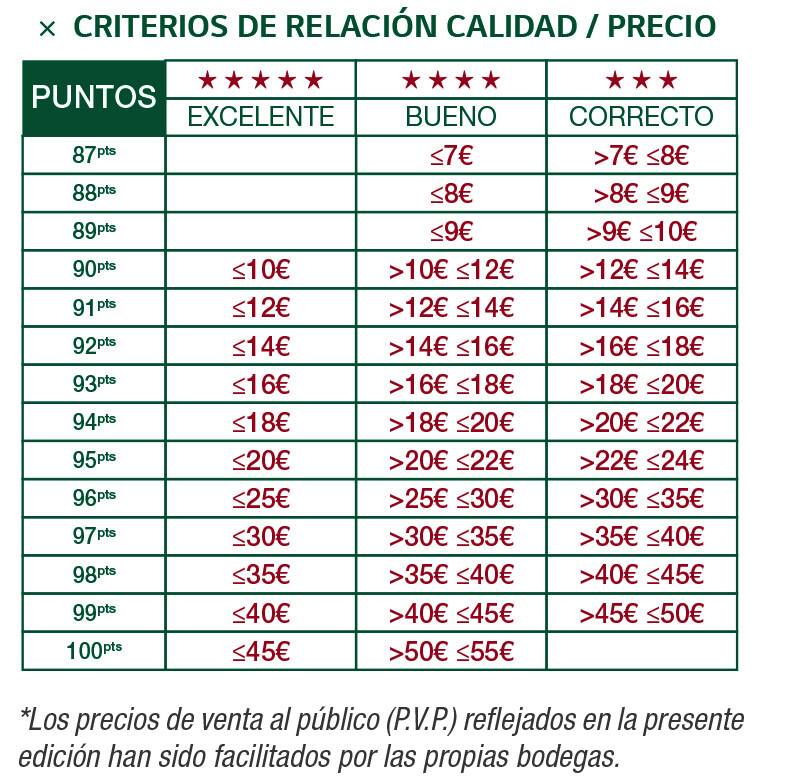WHO CARRIES OUT THE TASTINGS?

WHO CARRIES OUT THE TASTINGS?
Peñín has its own team of tasters. Each taster brings a different profile to the team in order to obtain a plural and consensual vision of the wines.
WHY TASTING IN THE PRODUCTION AREAS?

WHY TASTING IN THE PRODUCTION AREAS?
Tasting in the production areas benefits the tasting process threefold. On the one hand, contact is maintained with the technical managers of the regulatory councils, who provide the tasters with all the necessary information on varieties, harvesting procedures, climatic variables, etc. Secondly, tasting the wines together with their siblings allows for a more effective interpretation of the 'typicity' of the area. And finally, it allows the wines to be grouped by vintage, type and sub-zone in order to extract more detailed information about the area in question
WHAT ARE THE TASTING CRITERIA OF THE PEÑIN GUIDE?

WHAT ARE THE TASTING CRITERIA OF THE PEÑIN GUIDE?
The tastings and ratings of the Peñín Guide aim to show a real assessment according to a standard of balance, representativeness with the area (soil, climate, variety), as well as excellence and complexity in the best cases.
IS THERE ANY COST FOR WINERIES/PRODUCERS TO BE INCLUDED IN THE GUIDE?

IS THERE ANY COST FOR WINERIES/PRODUCERS TO BE INCLUDED IN THE GUIDE?
None. Any company (winery, marketer, distributor or distillery) can send wines, vermouths or distillates to be tasted by the guide without incurring any cost. If you have never sent samples to the Guide you should send an email to elaymuns@guiapenin.com requesting information about tasting dates for your product. If you have already sent product samples before, wait to receive the tasting call for your product through the usual channels.
WHY ARE WINES TASTED EVERY YEAR BUT NOT DISTILLATES AND VERMOUTHS?

WHY ARE WINES TASTED EVERY YEAR BUT NOT DISTILLATES AND VERMOUTHS?
Distillates and vermouths are products that are less exposed to the variability of the year, partly because they are products that are produced generally without being tied to a year and also because producers seek to create a style that remains unchanged from one year to the next.
Scores and rankings
WHAT DOES THE SCORE MEAN AND WHY IS THIS SCALE (50-100 POINTS) USED?

WHAT DOES THE SCORE MEAN AND WHY IS THIS SCALE (50-100 POINTS) USED?
In the world of wine prescription there are different scoring scales. The Peñín Guide started using the Spanish system, which goes from 0 to 10, but in 1992 it adopted the American system, which goes from 50 to 100, as it had the greatest international projection. According to this scoring system, 50 would be equivalent to 0 and 100 to 10 points.
WHAT DO THE STARS MEAN?

WHAT DO THE STARS MEAN?
Guía Peñín uses a system that highlights the best value for money of the wines by means of stars (*). At different levels of quality (score) it is acceptable to spend more or less on the wine, so the evaluation of this value for money is made by crossing the variables of price and score. This system distinguishes between Correct (3 stars), Good (4 stars) and Excellent (5 stars) value for money. The price range set for each value for money can be seen in the following table.

WHAT DOES THE LEGEND "WINE PENDING RECATA" MEAN?

WHAT DOES THE LEGEND "WINE PENDING RECATA" MEAN?
Those wines that are scored by Guía Peñín tasters with 95 points or more are called again in July to be re-tasted and compared with the best wines of the year. When we say that a wine is "pending recata", we mean that it will be evaluated again in a comparative tasting and that this evaluation will be used to offer the final score.
WHAT IS THE "PODIUM"?

WHAT IS THE "PODIUM"?
These are the best rated wines of the year. They are unique wines, which have uncommon qualities. To be included in the "Podium" a wine must obtain at least 95 Peñín points.
WHAT PRODUCTS DOES THE PEÑÍN GUIDE EVALUATE?

WHAT PRODUCTS DOES THE PEÑÍN GUIDE EVALUATE?
Wines from all over the world, vermouths and distillates.
 Einloggen
Einloggen

